Start开启线程源码分析
- Thread.start开启线程
public class JUC01 {
public static void main(String[] args) {
Thread t1 = new Thread(
() -> System.out.println("开启线程:"+Thread.currentThread().getName()),
"t1");
t1.start();
}
}
- start方法源码
public synchronized void start() {
/**
* This method is not invoked for the main method thread or "system"
* group threads created/set up by the VM. Any new functionality added
* to this method in the future may have to also be added to the VM.
*
* A zero status value corresponds to state "NEW".
*/
if (threadStatus != 0)
throw new IllegalThreadStateException();
/* Notify the group that this thread is about to be started
* so that it can be added to the group's list of threads
* and the group's unstarted count can be decremented. */
group.add(this);
boolean started = false;
try {
start0();
started = true;
} finally {
try {
if (!started) {
group.threadStartFailed(this);
}
} catch (Throwable ignore) {
/* do nothing. If start0 threw a Throwable then
it will be passed up the call stack */
}
}
}
- start方法中调用start0方法,start0方法是native方法,底层使用c++编写
private native void start0();
总结:
java线程是通过start的方法启动执行的,主要内容在native方法start0中,openjdk的写JNI一般是一一对应的,Thread.java对应的就是Thread.c,start0其实就是JVM_StartThread。此时查看源代码可以看到在jvm.h中找到了声明,jvm.cpp中有实现。
jvm配合操作系统,底层由操作系统分配了一个原生的基础线程。

Future接口
Future是Java5新加的一个接口,它提供了一种异步并行计算的功能。如果主线程需要执行一个很耗时的计算任务,我们就可以通过Future把这个任务放到异步线程中执行。主线程继续处理其他任务或者先行结束,再通过Future获取计算结果。
FutureTask类
FutureTask实现了RunnableFuture接口,RunnableFuture接口实现了Runnable接口和Future接口,FutureTask有一个构造方法:FutureTask(Callable callable)
实现Runnable接口后,可以使用new Thread(Runnable r)开启多线程;
Future接口中有可以取消已启动的线程的方法;
FutureTask的构造方法FutureTask(Callable callable)使用构造注入的方式将Callable为自身所用,可以使用Callable接口的call方法编写多线程的逻辑,且call方法有返回值。
实例:
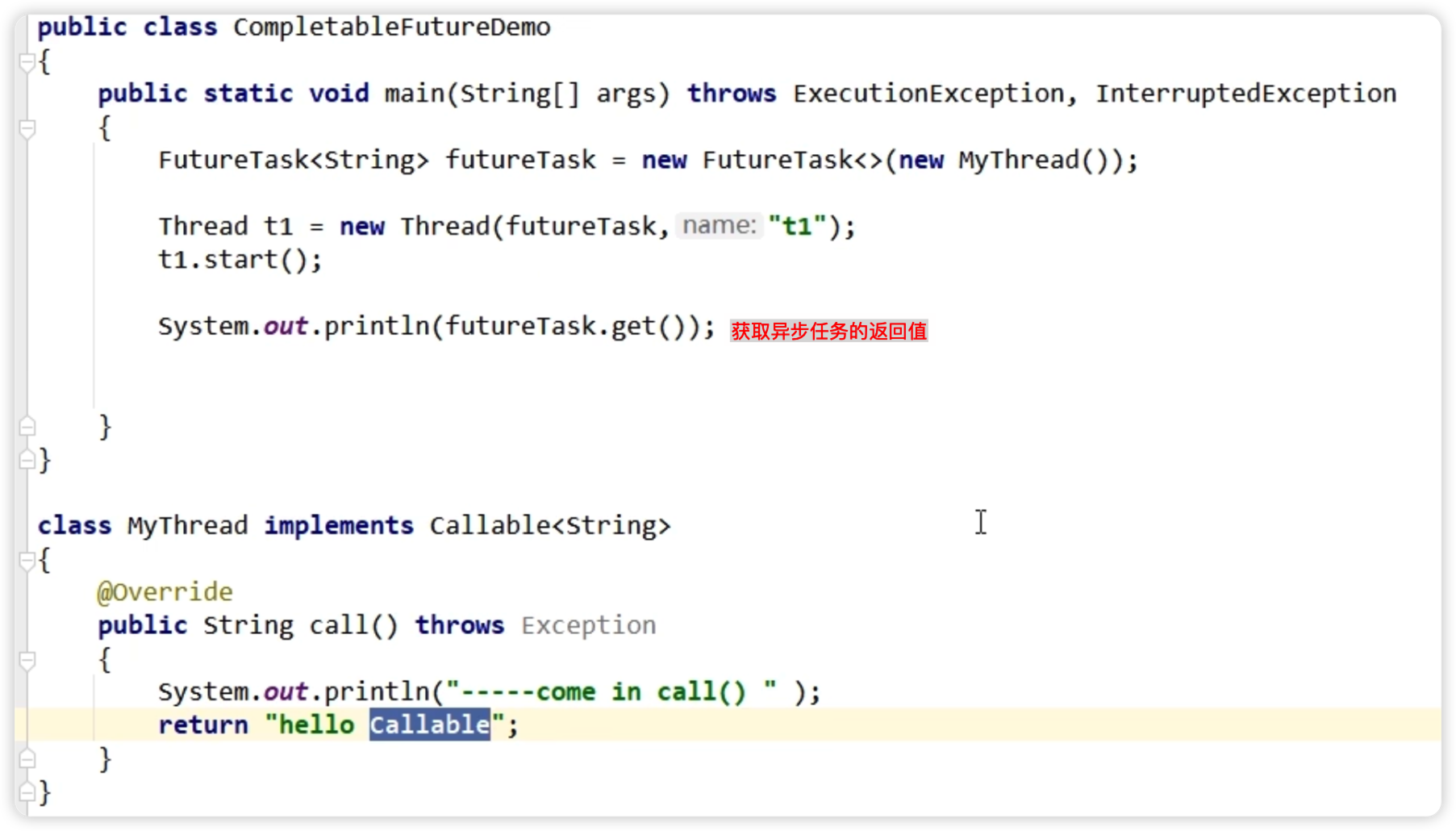
FutureTask的缺点:
- get方法容易阻塞
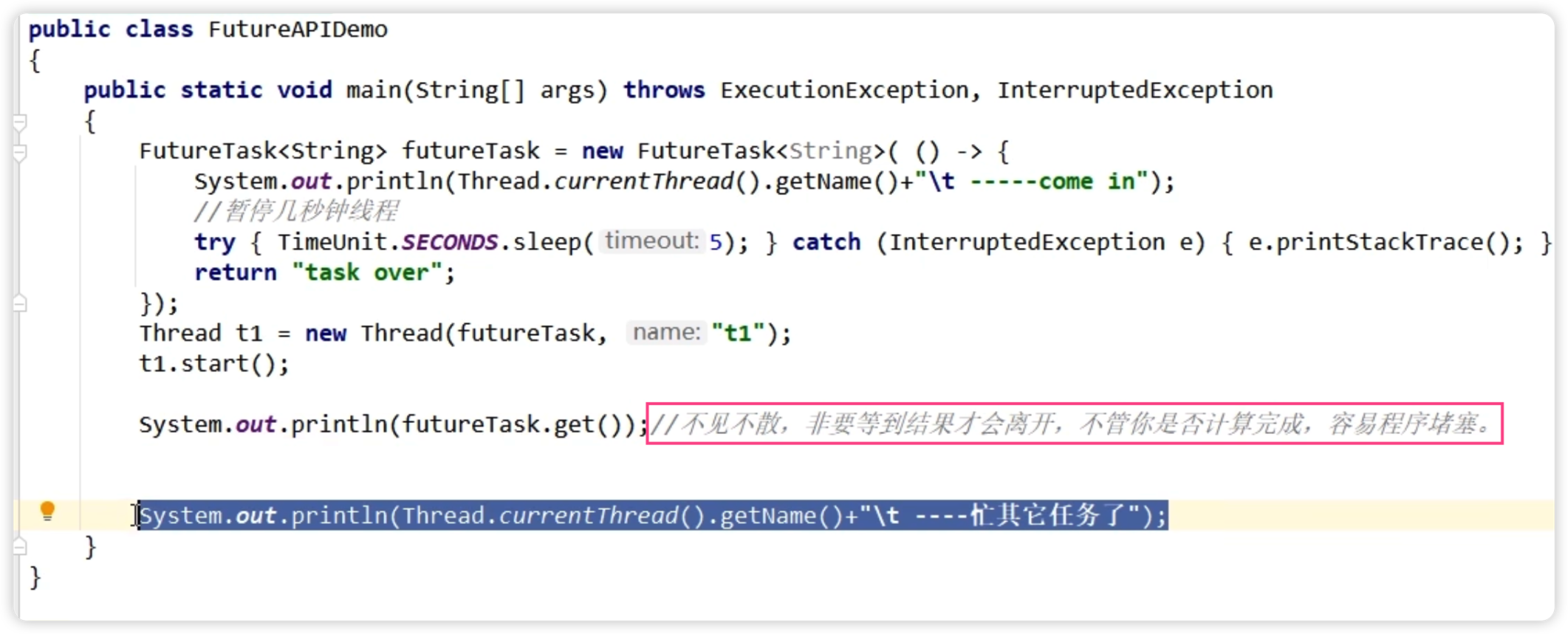
一般建议将get方法放在程序后面,假如不愿意等待很长时间,可以使用get(long timeout, TimeUnit unit)设置超时自动离开。

- isDone轮询会耗费无谓的cpu资源,而且也不见得能及时地得到计算结果。

结论:Future对于结果的获取不是很友好,只能通过阻塞或轮询的方式得到任务的结果。
CompletableFuture类
get方法阻塞的方式和异步编程的设计理念相违背,而轮询的方式会耗费无谓的CPU资源。因此,
JDK8设计出CompletableFuture。
CompletableFuture提供了一种观察者模式类似的机制,可以让任务执行完成后通知监听的一方。
在Java8中,CompletableFuture提供了非常强大的Future的扩展功能,可以帮助我们简化异步编程的复杂性,并且提供了函数式编程的能力,可以通过回调的方式处理计算结果,也提供了转换和组合 CompletableFuture的方法。它可能代表一个明确完成的Future,也有可能代表一个完成阶段(CompletionStage),它支持在计算完成以后触发一些函数或执行某些动作。
public class CompletableFuture<T> implements Future<T>, CompletionStage<T> {}
CompletionStage接口:
CompletionStage代表异步计算过程中的某一个阶段,一个阶段完成以后可能会触发另外一个阶段,有些类似Linux系统的管道分隔符传参数:
- CompletionStage代表异步计算过程中的某一个阶段,一个阶段完成以后可能会触发另外一个阶段
- 一个阶段的计算执行可以是一个Function,Consumer或Runnable。 比如:
stage.thenApply(x -> square(x)).thenAccept(x -> System.out.print(x)).thenRun(() -> System.out.printin()) - 一个阶段的执行可能是被单个阶段的完成触发,也可能是由多个阶段一起触发
四个静态方法
尽量不要使用构造方法获得CompletableFuture对象,尽量使用四个静态方法获取。
- 返回值为Void
public static CompletableFuture<Void> runAsync(Runnable runnable)
public static CompletableFuture<Void> runAsync(Runnable runnable,Executor executor)
- 返回值为泛型U
public static <U> CompletableFuture<U> supplyAsync(Supplier<U> supplier)
public static <U> CompletableFuture<U> supplyAsync(Supplier<U> supplier,Executor executor)
参数:
- Executor:
没有传入指定的Executor,直接使用默认的ForkJoinPool.commonPool()作为它的线程池执行异步代码
如果指定线程池,则使用我们自定义的或者特别指定的线程池执行异步代码
- Runnable:
传入Runnable的两个方法均无返回值
- Supplier
供给型函数接口

实例:
runAsync方法不传入线程池
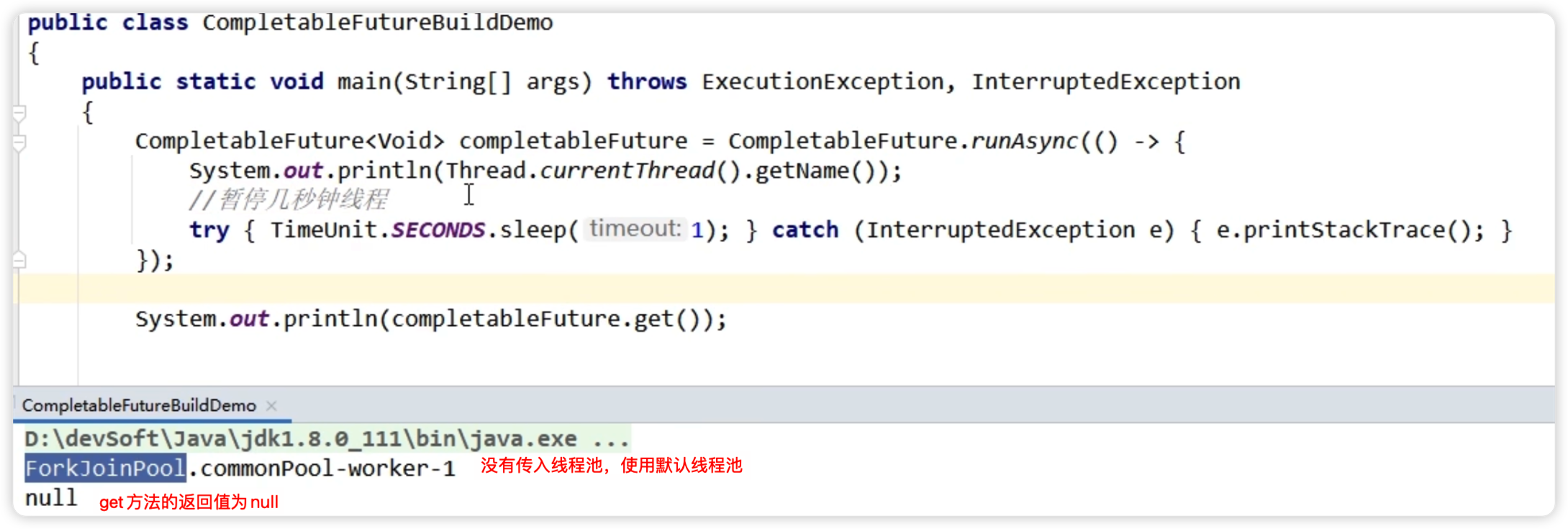
runAsync方法传入线程池

supplyAsync方法不传入线程池


CompletableFuture的使用
从Java8开始引入了CompletableFuture,它是Future的功能增强版,减少阻塞和轮询,可以传入回调对象,当异步务完成或者发生异常时,自动调用回调对象的回调方法。
实例:
import java.util.concurrent.*;
public class JUC01 {
public static void main(String[] args) {
//创建线程池
ExecutorService threadPool = Executors.newFixedThreadPool(3);
try {
CompletableFuture.supplyAsync(() -> {
System.out.println(Thread.currentThread().getName() + "------come in");
int result = ThreadLocalRandom.current().nextInt(10);
try {
TimeUnit.SECONDS.sleep(1);
} catch (InterruptedException e) {
e.printStackTrace();
}
System.out.println("------1秒钟后出结果" + result);
return result;
}, threadPool)
//当上一步(supplyAsync)运行结束时执行whenComplete分支,v表示上一步返回的结果,e表示上一步出现的异常
//注意:无论上一步(supplyAsync)是否出现异常,都会执行whenComplete分支
.whenComplete((v, e) -> {
if (e == null) { //上一步不出现异常时执行
System.out.println("------计算完成,更新系统UpdateValue:" + v);
}
})
//当上一步(supplyAsync)出现异常时执行exceptionally分支,e表示上一步出现的异常
.exceptionally(e -> {
e.printStackTrace();
System.out.println("异常情况:" + e.getCause() + "\t" + e.getMessage());
return null;
});
System.out.println(Thread.currentThread().getName()+"线程先去往其他任务");
}catch (Exception e){
e.printStackTrace();
}finally {
//关闭线程池
threadPool.shutdown();
}
}
}

注意:使用默认的线程池时,会把CompletableFuture.supplyAsync产生的线程设置为守护线程,当main线程结束时,守护线程也会随之结束。
优点

get和join
get方法和join方法都能获得线程的返回值,区别是get会抛出受检异常,join会抛出非受检异常(运行时异常)。
get方法:

join方法:

函数式接口与链式调用
函数式接口
Runnable
无参数、无返回值

Function
功能型函数式接口,有1个参数,有返回值

Consumer
消费型函数式接口,有1参数,无返回值
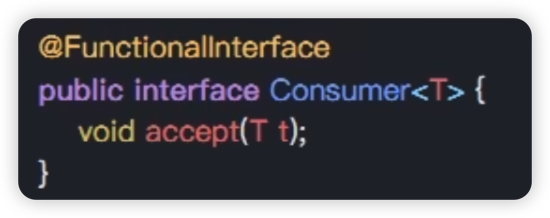
BiConsumer
BiConsumer<T, U> 接受2个参数(Bi,英文单词词根,代表两个的意思),没有返回值

Supplier
供给型函数式接口,没有参数,有返回值
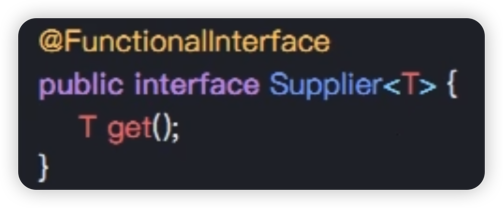
总结

链式调用 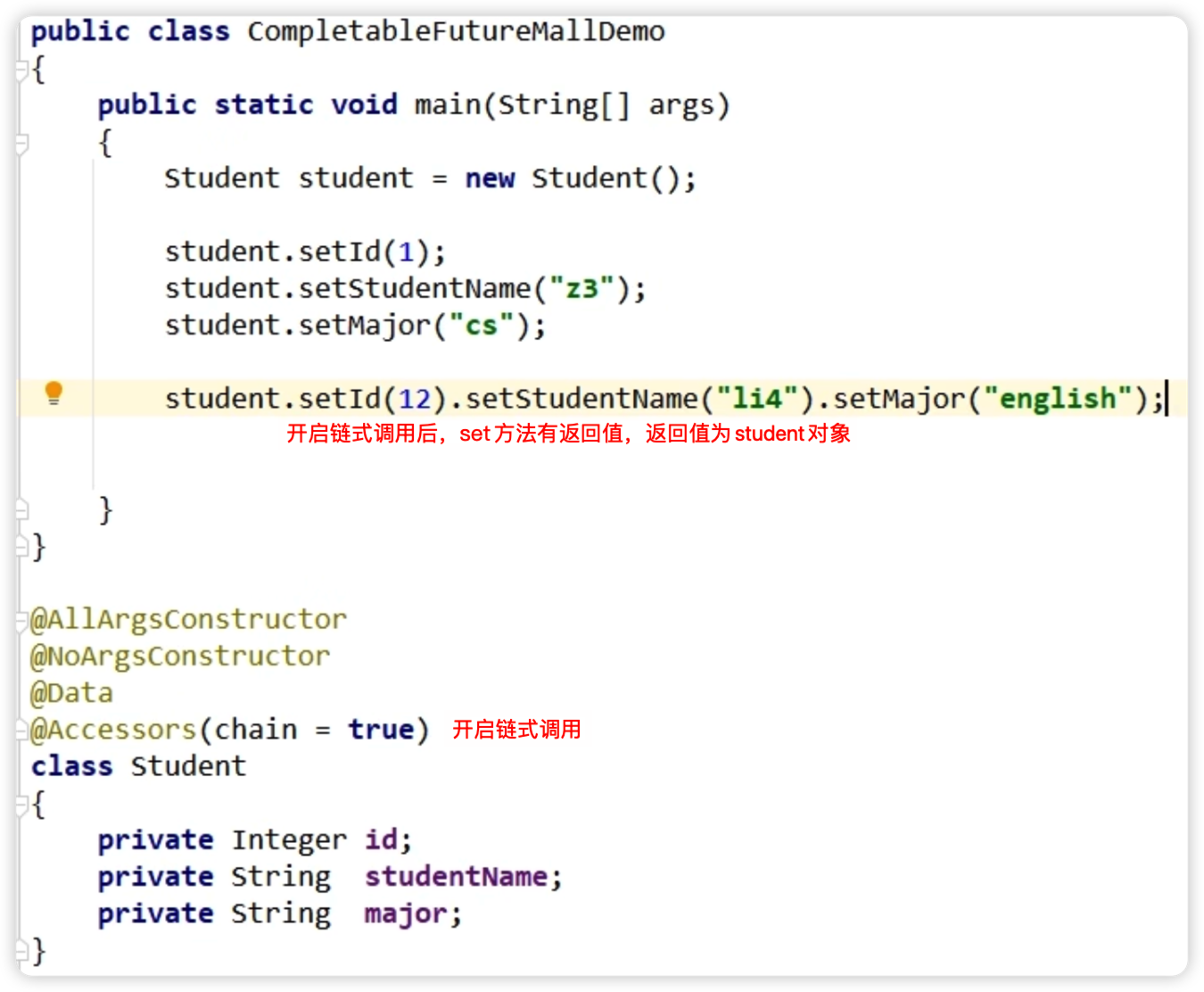
电商比价
案例说明:电商比价需求,模拟如下情况:
- 需求:
1.1 同一款产品,同时搜索出同款产品在多大电商平台的售价;
1.2 同一款产品,同时搜索出本产品在同一个电商平台下,各个入驻卖家售价是多少 - 输出:
出来结果希望是同款产品的在不同地方的价格清单列表,返回一个List<String>
《mysql》 in jd price is 88.05
《mysql》in dangdang price is 86.11
《mysql》 in taobao price is 90.43
- 技术要求
3.1 函数式编程
3.2 链式編程
3.3 stream流式计算
测试1:单线程执行
import lombok.AllArgsConstructor;
import lombok.Data;
import java.util.Arrays;
import java.util.List;
import java.util.concurrent.ThreadLocalRandom;
import java.util.concurrent.TimeUnit;
import java.util.stream.Collectors;
public class JUC03 {
/**
* 电商列表
*/
static List<NetMall> list= Arrays.asList(
new NetMall("jd"),
new NetMall("taobao"),
new NetMall("dangdang")
);
public static List<String> getPrice(List<NetMall> list,String productName){
return list
.stream()
.map(
netMall -> String.format(productName + " in %s price is %.2f",
netMall.getName(),
netMall.calcPrice(productName)))
.collect(Collectors.toList());
}
public static void main(String[] args) {
long startTime = System.currentTimeMillis();
getPrice(list, "mysql").forEach(System.out::println);
long endTime = System.currentTimeMillis();
System.out.println("--------costTime:"+(endTime-startTime)+"毫秒");
}
}
/**
* 电商类
*/
@Data
@AllArgsConstructor
class NetMall{
/**
* 电商名称
*/
private String name;
/**
* 模拟查询商品的价格
*/
public double calcPrice(String productName){
try {
TimeUnit.SECONDS.sleep(1);
} catch (InterruptedException e) {
e.printStackTrace();
}
return ThreadLocalRandom.current()
.nextDouble()*2+productName.charAt(0);
}
}
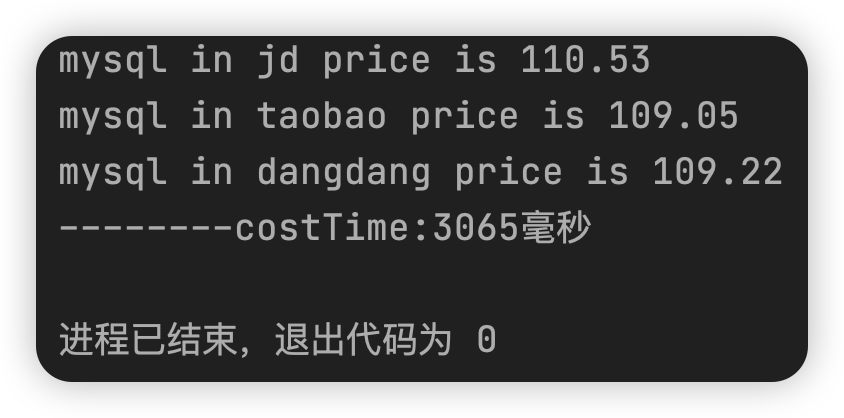
测试2:并行流:stream().parallel(),缺点:并行流不能设置线程池
import lombok.AllArgsConstructor;
import lombok.Data;
import java.util.Arrays;
import java.util.List;
import java.util.concurrent.ThreadLocalRandom;
import java.util.concurrent.TimeUnit;
import java.util.stream.Collectors;
public class JUC03 {
/**
* 电商列表
*/
static List<NetMall> list= Arrays.asList(
new NetMall("jd"),
new NetMall("taobao"),
new NetMall("dangdang")
);
public static List<String> getPrice(List<NetMall> list,String productName){
return list
.stream()
.parallel()
.map(
netMall -> String.format(productName + " in %s price is %.2f",
netMall.getName(),
netMall.calcPrice(productName)))
.collect(Collectors.toList());
}
public static void main(String[] args) {
long startTime = System.currentTimeMillis();
getPrice(list, "mysql").forEach(System.out::println);
long endTime = System.currentTimeMillis();
System.out.println("--------costTime:"+(endTime-startTime)+"毫秒");
}
}
/**
* 电商类
*/
@Data
@AllArgsConstructor
class NetMall{
/**
* 电商名称
*/
private String name;
/**
* 模拟查询商品的价格
*/
public double calcPrice(String productName){
try {
TimeUnit.SECONDS.sleep(1);
} catch (InterruptedException e) {
e.printStackTrace();
}
return ThreadLocalRandom.current()
.nextDouble()*2+productName.charAt(0);
}
}
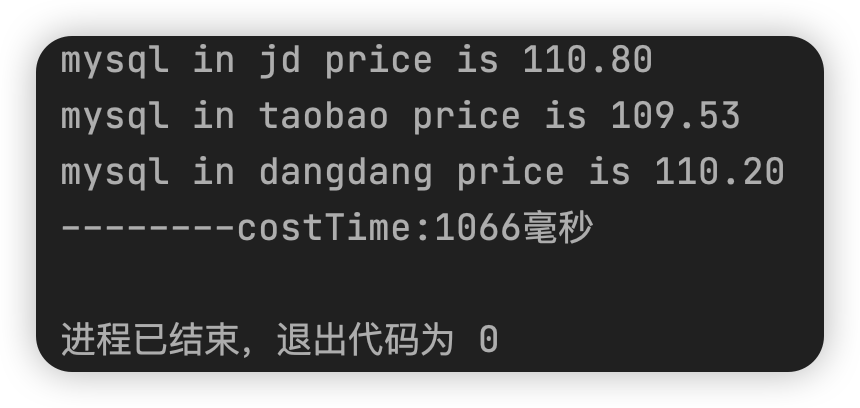
测试3:异步多任务
import lombok.AllArgsConstructor;
import lombok.Data;
import java.util.Arrays;
import java.util.List;
import java.util.concurrent.CompletableFuture;
import java.util.concurrent.ThreadLocalRandom;
import java.util.concurrent.TimeUnit;
import java.util.stream.Collectors;
public class JUC03 {
/**
* 电商列表
*/
static List<NetMall> list= Arrays.asList(
new NetMall("jd"),
new NetMall("taobao"),
new NetMall("dangdang")
);
public static List<String> getPrice(List<NetMall> list,String productName){
return list.stream().map(netMall ->
CompletableFuture.supplyAsync(() ->
String.format(productName + "in %s price is %.2f",
netMall.getName(),
netMall.calcPrice(productName))))
.collect(Collectors.toList())
.stream()
.map(CompletableFuture::join)
.collect(Collectors.toList());
}
public static void main(String[] args) {
long startTime = System.currentTimeMillis();
getPrice(list, "mysql").forEach(System.out::println);
long endTime = System.currentTimeMillis();
System.out.println("--------costTime:"+(endTime-startTime)+"毫秒");
}
}
/**
* 电商类
*/
@Data
@AllArgsConstructor
class NetMall{
/**
* 电商名称
*/
private String name;
/**
* 模拟查询商品的价格
*/
public double calcPrice(String productName){
try {
TimeUnit.SECONDS.sleep(1);
} catch (InterruptedException e) {
e.printStackTrace();
}
return ThreadLocalRandom.current()
.nextDouble()*2+productName.charAt(0);
}
}

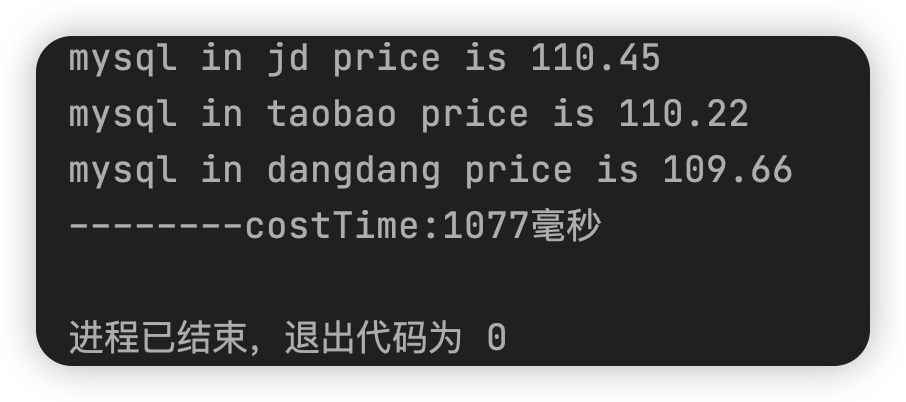
CompletableFuture常用方法
获取结果和触发计算的方法
获取结果:
public T get() throws InterruptedException, ExecutionException
等待返回结果,会发生阻塞(不见不散)
public T get(long timeout, TimeUnit unit) throws InterruptedException, ExecutionException, TimeoutException
设置超时时间,超过时间还没有返回结果则抛出异常(过时不候)
public T join()
和get()效果相同,不会抛出受检异常
public T getNow(T valueIfAbsent)
立即获取结果不阻塞,如果没计算完,则返回设定的valueIfAbsent值,如果计算完成,则返回完成后的结果
主动触发计算:
public boolean complete(T value)
是否打断了get/join方法,如果打断了,则将value返回给get/join方法,并返回true;如果没打断,
则不会将value返回给get/join方法,并返回false;
- 打断get/join方法:
import java.util.concurrent.CompletableFuture;
import java.util.concurrent.TimeUnit;
public class JUC03 {
public static void main(String[] args) {
CompletableFuture<String> completableFuture = CompletableFuture.supplyAsync(() -> {
try {
TimeUnit.SECONDS.sleep(2);
} catch (InterruptedException e) {
e.printStackTrace();
}
return "abc";
});
System.out.println(completableFuture.complete("计算未完成,将自定义的值返回给你吧"));
System.out.println(completableFuture.join());
}
}
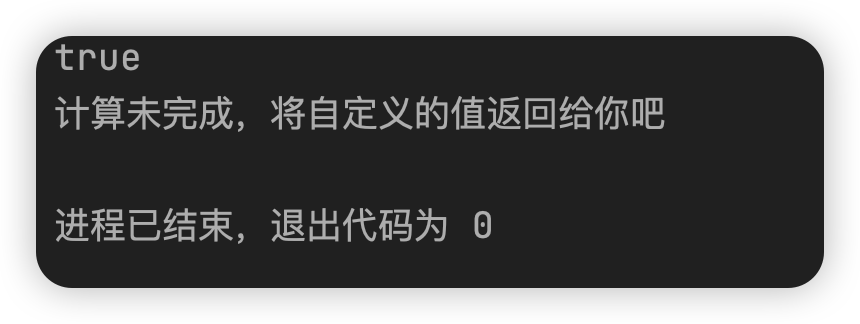
- 未打断get/join方法
import java.util.concurrent.CompletableFuture;
import java.util.concurrent.TimeUnit;
public class JUC03 {
public static void main(String[] args) {
CompletableFuture<String> completableFuture = CompletableFuture.supplyAsync(() -> {
try {
TimeUnit.SECONDS.sleep(2);
} catch (InterruptedException e) {
e.printStackTrace();
}
return "abc";
});
try {
TimeUnit.SECONDS.sleep(3);
} catch (InterruptedException e) {
e.printStackTrace();
}
System.out.println(completableFuture.complete("计算未完成,将自定义的值返回给你吧"));
System.out.println(completableFuture.join());
}
}
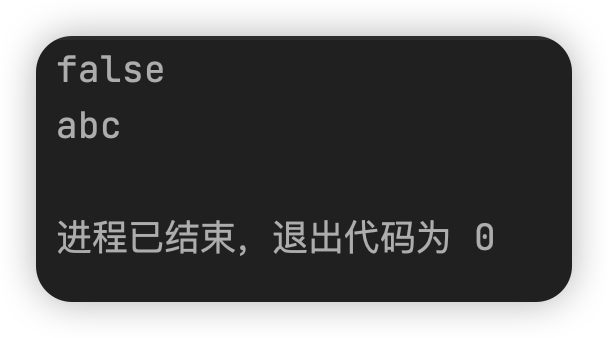
**注意:**get/join方法放在complete之后,get/join方法永远不会阻塞,因为异步任务如果没计算完,complete方法会将value给get/join方法,get/join方法获取的是value,不会发生阻塞;异步任务如果已经计算完成,则会将计算结果返回给get/join方法,更不会阻塞。
对计算结果进行处理的方法
public <U> CompletableFuture<U> thenApply( Function<? super T,? extends U> fn)
计算结果存在依赖关系,这两个线程串行化。
**实例:**买鱼,杀鱼,腌鱼存在依赖关系,需要串行处理,而腌鱼的过程中可以去打游戏,所以打游戏和腌鱼是并行处理。
import java.util.concurrent.CompletableFuture;
import java.util.concurrent.ExecutorService;
import java.util.concurrent.Executors;
import java.util.concurrent.TimeUnit;
public class JUC03 {
public static void main(String[] args) {
ExecutorService threadPool = Executors.newFixedThreadPool(3);
try {
CompletableFuture.supplyAsync(() -> {
try {
TimeUnit.SECONDS.sleep(2);
} catch (InterruptedException e) {
e.printStackTrace();
}
System.out.println("第一步、买鱼");
return 1;
}, threadPool).thenApply(f -> {
System.out.println("第二步、杀鱼");
return f + 2;
}).thenApply(f -> {
System.out.println("第三步、腌鱼");
return f + 3;
}).whenComplete((v, e) -> {
if (e == null) {
System.out.println("-----正在腌鱼:" + v);
}
}).exceptionally(e -> {
e.printStackTrace();
System.out.println(e.getMessage());
return null;
});
System.out.println(Thread.currentThread().getName() + "----腌鱼的过程中可以先去打游戏");
}catch (Exception e){
e.printStackTrace();
}finally {
threadPool.shutdown();
}
}
}

**异常处理:**由于存在依赖关系(当前步错,不走下一步),当前步骤有异常的话就叫停。
import java.util.concurrent.CompletableFuture;
import java.util.concurrent.ExecutorService;
import java.util.concurrent.Executors;
import java.util.concurrent.TimeUnit;
public class JUC03 {
public static void main(String[] args) {
ExecutorService threadPool = Executors.newFixedThreadPool(3);
try {
CompletableFuture.supplyAsync(() -> {
try {
TimeUnit.SECONDS.sleep(2);
} catch (InterruptedException e) {
e.printStackTrace();
}
System.out.println("第一步、买鱼");
return 1;
}, threadPool).thenApply(f -> {
//出现异常
int i=1/0;
System.out.println("第二步、杀鱼");
return f + 2;
}).thenApply(f -> {
System.out.println("第三步、腌鱼");
return f + 3;
}).whenComplete((v, e) -> {
if (e == null) {
System.out.println("-----正在腌鱼:" + v);
}
}).exceptionally(e -> {
e.printStackTrace();
System.out.println(e.getMessage());
return null;
});
System.out.println(Thread.currentThread().getName() + "----腌鱼的过程中可以先去打游戏");
}catch (Exception e){
e.printStackTrace();
}finally {
threadPool.shutdown();
}
}
}

public <U> CompletableFuture<U> handle( BiFunction<? super T, Throwable, ? extends U> fn)
效果和thenApply方法相同,但是有异常也可以往下一步走,根据带的异常参数可以进一步处理
import java.util.concurrent.CompletableFuture;
import java.util.concurrent.ExecutorService;
import java.util.concurrent.Executors;
import java.util.concurrent.TimeUnit;
public class JUC03 {
public static void main(String[] args) {
ExecutorService threadPool = Executors.newFixedThreadPool(3);
try {
CompletableFuture.supplyAsync(() -> {
try {
TimeUnit.SECONDS.sleep(2);
} catch (InterruptedException e) {
e.printStackTrace();
}
System.out.println("第一步、买鱼");
return 1;
}, threadPool).handle((f,e) -> {
System.out.println("第二步、杀鱼");
return f + 2;
}).handle((f,e) -> {
System.out.println("第三步、腌鱼");
return f + 3;
}).whenComplete((v, e) -> {
if (e == null) {
System.out.println("-----正在腌鱼:" + v);
}
}).exceptionally(e -> {
e.printStackTrace();
System.out.println(e.getMessage());
return null;
});
System.out.println(Thread.currentThread().getName() + "----腌鱼的过程中可以先去打游戏");
}catch (Exception e){
e.printStackTrace();
}finally {
threadPool.shutdown();
}
}
}
异常处理:
import java.util.concurrent.CompletableFuture;
import java.util.concurrent.ExecutorService;
import java.util.concurrent.Executors;
import java.util.concurrent.TimeUnit;
public class JUC03 {
public static void main(String[] args) {
ExecutorService threadPool = Executors.newFixedThreadPool(3);
try {
CompletableFuture.supplyAsync(() -> {
try {
TimeUnit.SECONDS.sleep(2);
} catch (InterruptedException e) {
e.printStackTrace();
}
System.out.println("第一步、买鱼");
return 1;
}, threadPool).handle((f,e) -> {
//出现异常
int i=1/0;
System.out.println("第二步、杀鱼");
return f + 2;
}).handle((f,e) -> {
System.out.println("第三步、腌鱼");
return f + 3;
}).whenComplete((v, e) -> {
if (e == null) {
System.out.println("-----正在腌鱼:" + v);
}
}).exceptionally(e -> {
e.printStackTrace();
System.out.println(e.getMessage());
return null;
});
System.out.println(Thread.currentThread().getName() + "----腌鱼的过程中可以先去打游戏");
}catch (Exception e){
e.printStackTrace();
}finally {
threadPool.shutdown();
}
}
}

第二步19行位置出现异常,所以不会执行System.out.println("第二步、杀鱼");和return f + 2;,所以在第三步return f + 3;位置会出现空指针异常。
对计算结果进行消费方法
public CompletableFuture<Void> thenAccept(Consumer<? super T> action)
接收任务的处理结果,并消费处理,无返回结果。
任务A 执行完执行 B,B需要A的结果,但是任务B无返回值
import java.util.concurrent.CompletableFuture;
public class JUC03 {
public static void main(String[] args) {
CompletableFuture.supplyAsync(() -> {
System.out.println("第一步、买鱼");
return 1;
}).handle((f,e) -> {
System.out.println("第二步、杀鱼");
return f + 2;
}).handle((f,e) -> {
System.out.println("第三步、腌鱼");
return f + 3;
}).thenAccept(integer -> System.out.println(integer));
}
}
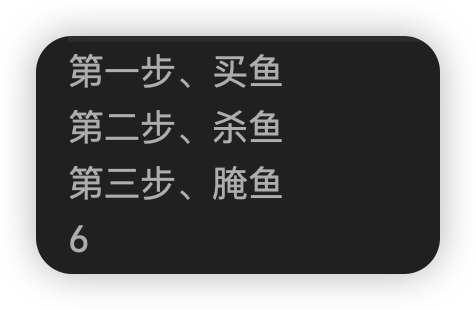
**总结:**thenRun、thenAccept、thenApply对比

代码演示:

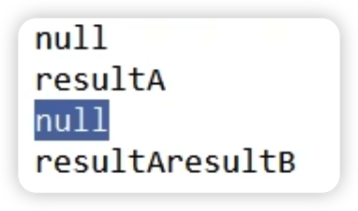
xxx方法和xxxAsync方法对比
xxx方法有:thenRun、thenAccept、thenApply
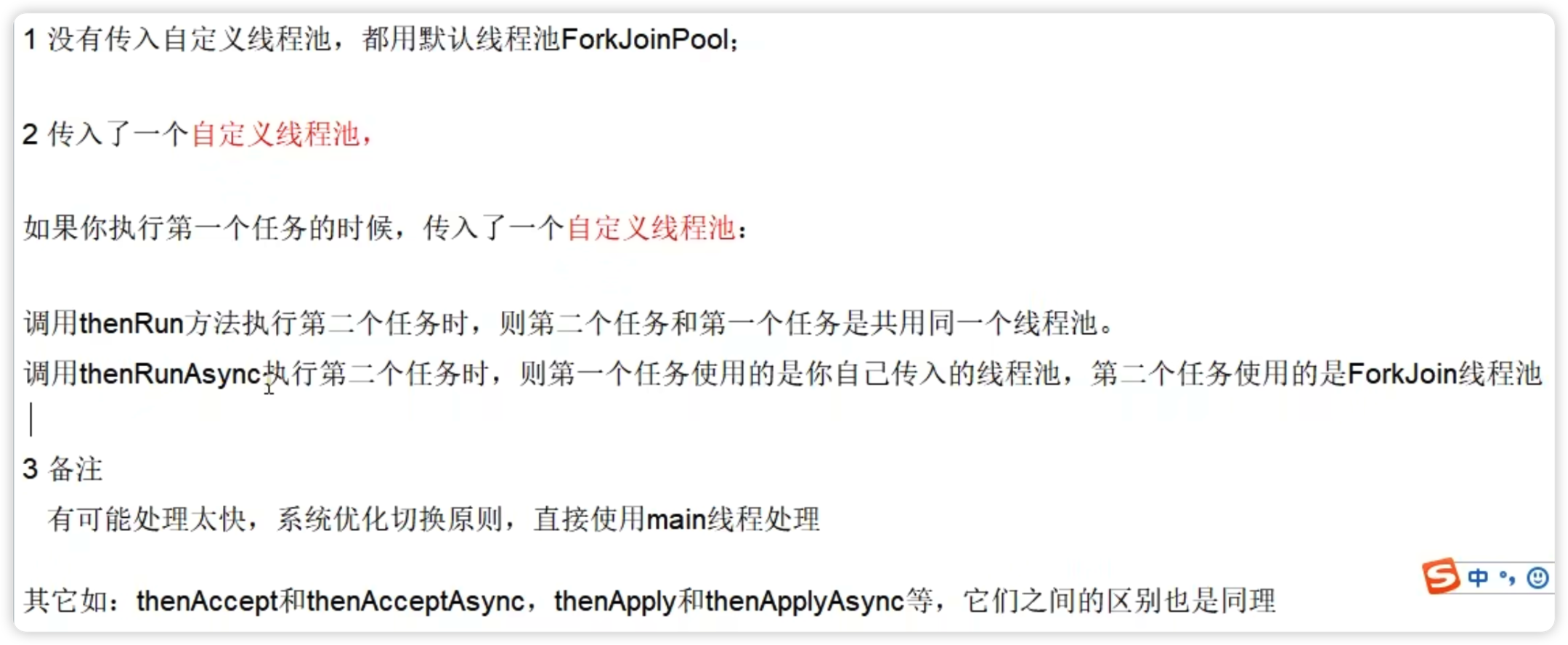
对计算速度进行选用的方法
public <U> CompletableFuture<U> applyToEither( CompletionStage<? extends T> other, Function<? super T, U> fn)
两个CompletableFuture对象进行比较,哪个先计算完就对哪个CompletableFuture的返回值使用Function<? super T, U> fn进行处理,然后返回先计算完的CompletableFuture对象。
import java.util.concurrent.CompletableFuture;
import java.util.concurrent.TimeUnit;
public class JUC03 {
public static void main(String[] args) {
CompletableFuture<String> playA = CompletableFuture.supplyAsync(() -> {
System.out.println("A come in");
try {
TimeUnit.MILLISECONDS.sleep(3);
} catch (InterruptedException e) {
e.printStackTrace();
}
return "playA";
});
CompletableFuture<String> playB = CompletableFuture.supplyAsync(() -> {
System.out.println("B come in");
try {
TimeUnit.MILLISECONDS.sleep(2);
} catch (InterruptedException e) {
e.printStackTrace();
}
return "playB";
});
CompletableFuture<String> result = playA.applyToEither(playB, f -> {
return f + " is winner";
});
System.out.println(Thread.currentThread().getName()+"\t--------:"+result.join());
}
}

对计算结果进行合并的方法
public <U,V> CompletableFuture<V> thenCombine( CompletionStage<? extends U> other, BiFunction<? super T,? super U,? extends V> fn)
两个CompletionStage任务都完成后,最终能把两个任务的结果一起交给thenCombine来处理,先完成的先等着,等待其它分支任务完成。
- 实例1
import java.util.concurrent.CompletableFuture;
import java.util.concurrent.TimeUnit;
public class JUC03 {
public static void main(String[] args) {
CompletableFuture<Integer> playA = CompletableFuture.supplyAsync(() -> {
System.out.println(Thread.currentThread().getName() + "\t ----启动");
try {
TimeUnit.MILLISECONDS.sleep(3);
} catch (InterruptedException e) {
e.printStackTrace();
}
return 30;
});
CompletableFuture<Integer> playB = CompletableFuture.supplyAsync(() -> {
System.out.println(Thread.currentThread().getName() + "\t ----启动");
try {
TimeUnit.MILLISECONDS.sleep(2);
} catch (InterruptedException e) {
e.printStackTrace();
}
return 20;
});
CompletableFuture<Integer> completableFuture = playA.thenCombine(playB, (x, y) -> {
System.out.println("-----开始两个结果合并");
return x + y;
});
System.out.println(completableFuture.join());
}
}

- 实例2:链式调用
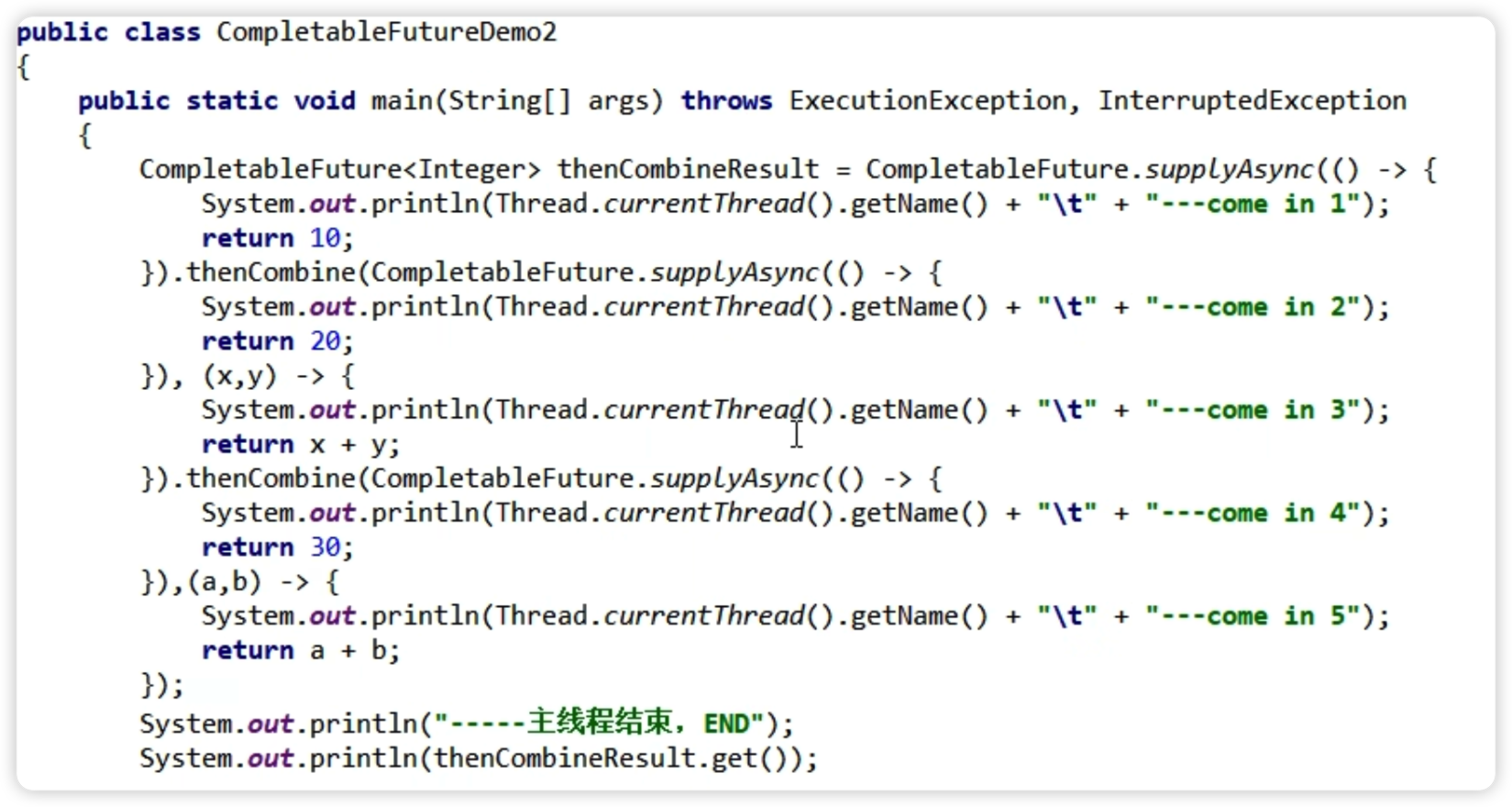





















 314
314











 被折叠的 条评论
为什么被折叠?
被折叠的 条评论
为什么被折叠?








